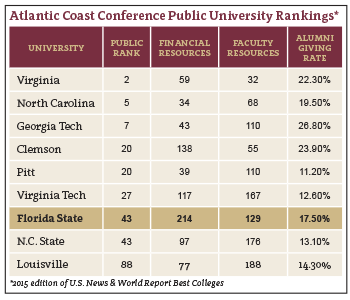Winning leads to windfall for FSU, coaches
"FSU’s athletic program saw a 14.7 percent increase in revenue and a 16.1 percent increase in expenses during the 2013-14 school year, according to a investigation into public athletic department finances published last week by USA Today.
The increases are directly related to FSU’s victory in the 2013 BCS National Championship Game, the school’s senior associate athletic director/chief financial officer Matt Behnke told the Tallahassee Democrat on Wednesday.
“It was clearly a perfect storm,” Behnke said. “And winning a national championship was a large part of it.”
The Seminoles saw dramatic increases in ticket sales ($25,550,753, up $5.24 million), contributions ($22,521,533, up $3.6 million) and rights/licensing ($40,493,922, up $3.7 million) over the last school year.
FSU also reported close to $20.8 million in revenues from NCAA/conference distributions.
According to Behnke, ticket sales for the 2013 national championship game in Pasadena accounted for the increase.
Winning the title increased royalties on officially-licensed merchandise and inspired contributions from members of Seminole Boosters, Inc. — which has specific financial thresholds to meet if members wish to take advantage of priority tickets and/or parking.
“The percentage increases we’ve seen related to both revenues and expenses were not outside of the range of what we saw with other schools who have won a national championship — so it was expected,” Behnke said.
Seminole self-sufficiency
"The ACC was the only member of the Power Five Conference to not have a school ranked amongst the Top 16 programs. FSU’s total revenue ranked 17th nationally and trailed $19.8 million behind the University of Florida, which ranked ninth and grossed $124.6 million.
Despite FSU’s position, Behnke said the athletic program is self-sufficient — meaning revenues exceeded expenses last season — thanks to net incomes accrued over the previous two school years ($2.9 million in 2012-13 and $2.1 million last year).
According to USA Today, all 50 Power Five schools are self-sufficient — but only when taking into account money collected from subsidies (student fees, university funding or direct government support).
FSU’s athletic program collected $7.98 million in student fees for the 2013-14 school year, but in turn does not charge students for tickets to sporting events.
When that money isn’t taken into account, only 24 of the 230 schools are operating at a profit — but FSU is not one of them, according to the story and a study by Indiana University's National Sports Journalism Center. The ACC was also the only conference in the Power Five not operating at a profit using that measurement.
Using that calculation, FSU accounted for $2.07 million more in expenses than revenues in the last school year.
“Here is the core difference with that particular analysis: we receive student athletic fees on a credit hour basis and in return provide all students with tickets to athletic events without additional charges or fees,” Behnke said. “That is how we continue to operate at Florida State. The way in which other institutions handle student athletic fees and tickets varies by institution.
“Based upon the analysis, if we sold student tickets in a manner similar to some, we would operate at a profit.”
FSU’s athletic program and Seminole Boosters, Inc., collectively also gave $2.625 million back to the school, which will be allocated however FSU’s administration decides to spend it, according to Behnke.
“So when you talk about being self-sufficient, being able to contribute back truly defines the program’s ability to be self-sufficient,” Behnke said.
“The university wouldn’t subsidize us only just to have athletics give it back, and I think maybe that’s more of an accurate picture. Athletics is one part of this great university, and giving back to the students annually is something that we all take great pride in.”
As far as the expenses go…
FSU spent $98,866,182 last year — the highest since USA Today began compiling the database in 2005. The total is up $14.1 million from the previous school year.
The Seminoles paid $32.7 million in coaching salaries and contract bonuses last year, up $5.5 million from the year before. FSU coach Jimbo Fisher earned $3.5 million and his nine assistants collectively earned $3.4 million before bonuses during the 2013-14 season.
FSU paid $9.5 million in scholarship money last year, and also saw an increase of $6.78 million in “other” expenses from the previous year to $42.9 million.
Behnke said the increase in spending also comes from more expensive team travel, including FSU’s trip to play for the national title in Pasadena, California, which cost about $2.8 million and resulted in a net loss of more than $480,000.
FSU also spent $1.87 million more than it did last year (about $13.8 million total) for “building/grounds,” which Behnke said covered locker room renovations for football team and recurring maintenance.
Florida State numbers
Total Revenue; $196,030,398
Total Expenses; $98,866,182
Total subsidy; $7,980,366
Percent subsidy; 7.62
FSU revenues
Ticket sales; $25,550,753
Contributions; $18,894,097
Rights/licensing; $40,493,922
Student fees; $7,980,366
School funds; $0
Other; $8,227,880
Total; $104,774,474
FSU expenses
Coaching/staff pay; $32,748,373
Scholarships; $9,471,927
Building/grounds; $13,786,951
Other; $42,858,931
Total Expenses; $98,866,182
Florida Public Schools
9. Florida; SEC; $124;611;305
17. Florida State; ACC; $104;774;474
56. UCF; AAC; $49;764;152
57. USF; AAC; $48;383;928
90. Florida International; C-USA; $$28;104;062
106. Florida Atlantic; C-USA; $24;352;818
154. Florida Gulf Coast; Atl Sun; $14;434;002
178. FAMU; MEAC; $12;444;254
205. North Florida; Atl Sun; $10;453;436
Top 5 Total Revenue schools:
1. Oregon; Pac-12; $196 million
2. Texas; Big 12; $161 million
3. Michigan; Big Ten; $157.9 million
4. Alabama; SEC; $153.2 million
5. Ohio State; Big Ten; $145.2 million
ACC Public Schools Total Revenues
1. Florida State; $104.8 million
2. Louisville; $88.7 million
3. North Carolina; $83.8 million
4. Virginia; $83.7 million
5. Clemson; $74.8 million
6. Virginia Tech; $73.1 million
7. N.C. State; $70.5 million
8. Georgia Tech; $68.5 million


![[Image: TVvsMax.jpg]](https://blogger.googleusercontent.com/img/b/R29vZ2xl/AVvXsEjccWED4IqePrH8aEQZsqDRjR6DLYxxs2AvhKEWEjhuNT38HM7WzsvZGkoeo2-3BlYuVJlIctmH7AgSYqfERNrT8nG2xRBvstC8ScMLHWU51nA9Lsb0CmwNJ-fvPnfblTIPjyijQljGevqX/s1600/TVvsMax.jpg)


